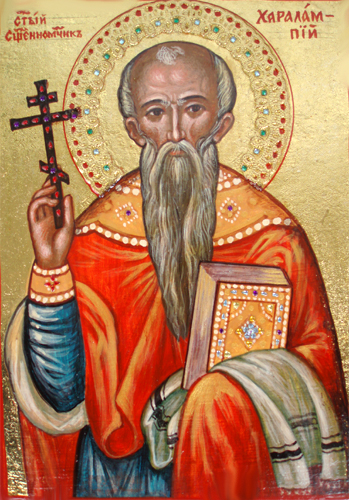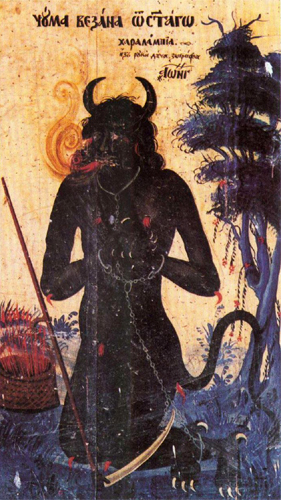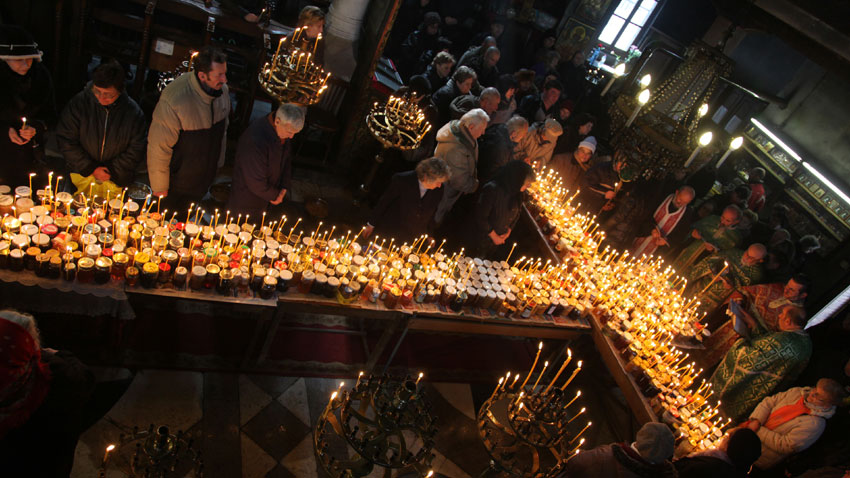On 10 February the church honours the memory of St. Haralampi (Haralambos) who died the death of a martyr during the persecution of Christians in the 3rd century. As recorded in his passional, he was born around the year 85 and died in 198. It is said that when his tormentors were tearing at his skin with nails of iron, his wounds miraculously healed every night. Before the heavenly angels took his soul up into the heavens, Haralambos prayed to God to give bodily health and salvation for the souls of all humans. That is why he is considered a saint of healing, alongside the Saints Cosmas and Damian, St. Panteleimon and St. Trifon. His relics are said to perform miracles: the little finger of his right hand is kept at the Sveti Sedmochislenitsi (seven saints) church in the centre of Sofia.
 In traditional Bulgarian culture, the saint, also known as Haralambi or Aralan Bey is seen as the master of sickness, but most of all of the disease people feared most – the plague. He is also the patron saint of beekeepers.
In traditional Bulgarian culture, the saint, also known as Haralambi or Aralan Bey is seen as the master of sickness, but most of all of the disease people feared most – the plague. He is also the patron saint of beekeepers.
From the early Middle Ages right up to the mid-19th century, the Black Death was a veritable scourge in Europe, decimating entire nations, wiping towns and villages off the face of the Earth, triggering drastic changes in the economy, in politics and the spiritual climate on the continent, including in the Bulgarian lands. Fighting off the Black Death was a task Christianity had taken upon itself and a number of saints came to be known as saviours of towns and whole regions from the pestilence. In Bulgarian tradition these are mostly the “winter” saints: St. Anthony (17 January), St. Athanasius (18 January), St. Euthymius (20 January) and especially - St. Haralambos.
 Legend has it that the plague was born on the day of St. Athanasius and started extirpating humans until St. Haralampi caught her, put her in chains or, alternately, shut her up in a glass bottle. But if the sins of men multiply, the saint shall be angry and shall let her free to punish them for their sins. This idea has made its way into icon painting and in many icons, the saint is painted as beating and torturing the plague, which, on her part is depicted as the devil, or as having stepped on the devil as a sign of her superiority over the evil demon. In one folk song from the region of Yambol, however, St. Haralampi appears as the plague’s “dear brother”. God has sent the saint to plead with her to stop raging in the town of Kotel: “Enough of her killing/killing and breaking/the pretty young brides/and handsome young lads/ but most of all shepherds/Their mothers crying pitifully/ their cries reaching up to the heavens.” But entreat her as he may, the saint’s “dear sister”, the plague was unmoved and threatened to kill him too, like “a chicken on St. Peter’s day”.
Legend has it that the plague was born on the day of St. Athanasius and started extirpating humans until St. Haralampi caught her, put her in chains or, alternately, shut her up in a glass bottle. But if the sins of men multiply, the saint shall be angry and shall let her free to punish them for their sins. This idea has made its way into icon painting and in many icons, the saint is painted as beating and torturing the plague, which, on her part is depicted as the devil, or as having stepped on the devil as a sign of her superiority over the evil demon. In one folk song from the region of Yambol, however, St. Haralampi appears as the plague’s “dear brother”. God has sent the saint to plead with her to stop raging in the town of Kotel: “Enough of her killing/killing and breaking/the pretty young brides/and handsome young lads/ but most of all shepherds/Their mothers crying pitifully/ their cries reaching up to the heavens.” But entreat her as he may, the saint’s “dear sister”, the plague was unmoved and threatened to kill him too, like “a chicken on St. Peter’s day”.
That the saint was held in high regard is evident from the fact that his name – Haralampi – was once very popular among Bulgarians in many parts of the country. Even in our day there are men called Haralampi, though more rarely. Quite a few towns and villages have taken St. Haralampi to be their patron saint, naming the local church after him, for example, or celebrating the day of St. Haralampi with a village fete. Once, on the day of St. Haralambos, also known as Chuminden (plague day), all rituals were observed strictly and any work done by women was forbidden. Women would bake ritual loaves of bread to honour the saint and mollify the plague and would often spread honey onto it – plague’s favourite. In some parts of the country honey would be taken to church to be thurified and was then kept at every home as medicine. That is the reason why beekeepers too started celebrating the day of St. Haralampi and took him as their patron saint. So, a winter beekeepers’ day appeared, alongside the summer day of St. Procopius, 8 July. The tradition came into being on this day to take the new honey to the temple to be thurified. In more modern times beekeeping associations in many towns across Bulgaria have chosen 10 February as their patron saint’s day and organize lectures, celebrations and even award prizes – like Queen Bee, for example, to the most proficient woman beekeeper.

Prof. Vihra Baeva is folklore expert at the Bulgarian Academy of Sciences Institute for Ethnology and Folklore Studies with Ethnographic Museum.
English version: Milena Daynova
The Philip Koutev National School of Folk Arts is not just any school - it is a talent laboratory. It is the first school not only in Bulgaria but in the Balkans for professional study of folklore. It is located in the heart of the beautiful town of..
Scientists from the Sorbonne will study the cultural heritage preserved in the Regional Ethnographic Open-Air Museum "Etar" , informs public broadcaster BNT. In March this year the French scientists together with experts of REOM "Etar" will study elements..
The day of St. Tryphon (1 February old style, 14 February new style) is celebrated by vine growers, falconers and gardeners in Bulgaria. Trifon Zarezan comes around with vine pruning and wine drinking St. Tryphon is believed to help..

+359 2 9336 661
